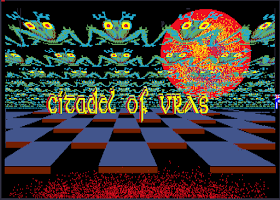 |
| A clear homage to Space Invaders? |
Citadel of Vras
Australia
 |
| The Nigris Spaceport serves as the main menu. |
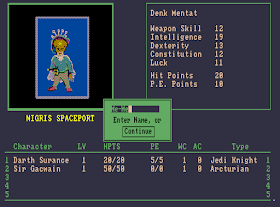 |
| Character creation. This Mentat does indeed look pretty Denk. |
As the game begins, the characters have no weapons or psychic abilities, and their only armor is basic spacesuits--which you have to equip immediately to avoid taking damage every few turns. Enemies start attacking immediately, so you spend a lot of time reloading until you find the store and training center to get some entry level weapons and base-level psychic abilities.
After that, the game is a lot like The Bard's Tale with a sci-fi patina. You march through featureless hallways and burst through doors, fighting random combats with aliens and robots (including Daleks), in search of the two or three squares per level that have anything interesting. Vras is somewhat easier than its cousins in that a) you can save anywhere; b) the combats on the first level almost never offer more than one enemy; and c) both hit points and spell points regenerate as you walk around.
Combat follows the basic structure established in Wizardry and retained by the Interplay titles. When you first meet an enemy, you have options to greet, flee, or attack. When the first two fail, they give the enemy a free round, so they're not often good options.
 |
| Initial combat options. |
If you attack, you specify an action for each character: attack, defend, or use a psychic ability. These actions execute all at once, in character order, at the end of the round. You watch the outcomes scroll by, designate a new set of actions at the end of the round, and so on until the enemy party is destroyed. You get experience, credits, and sometimes items from each slain enemy, equally distributed among party members.
 |
| Combat actions slowly scroll by. |
The psychic abilities, which function like spells in a fantasy RPG, make things a little too easy because (at least on the first two levels) they never fail. The Denk Mentat has a Level 1 ability called "Illusions" that distracts all enemies for one combat round. Its cost is so low that you can usually cast it on every enemy party and kill them before they can recover, then recover those psychic points before the next combat. At Level 2, the Mentat gets "Sleep," which lasts even longer. The Jedi similarly gets "Freeze Foes" at Level 2 that amounts to the same thing.
 |
| Jedi powers alas do not include Force Lightning. |
Physical attacks depend heavily on the weapon. At the beginning, you only have enough for staves, but soon you start finding weapons post-combat. Another source of treasure comes in the form of randomly-encountered lockers that you need some kind of tool to open. Pretty soon, characters are wielding needle guns, plasma axes, atomic lasers, blasters, and so forth. On Level 2, I found a weapon called a "neuronic whip" that damages all enemies in a party, not just one.
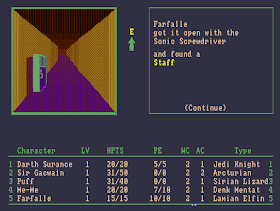 |
| Lockers pop up randomly as you explore. |
Other items found in the shop and abroad include various pieces of armor (tangle fields, repellor belts, carbal cloaks) and utilities like flashlights and sonic screwdrivers. There are a bunch of things whose use is unknown to me, like silver amulets and gold plates (they may just be for sale). Some enemy attacks damage spacesuits, so it's best to keep a few spares.
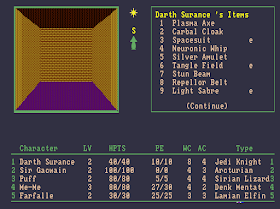 |
| My inventory. A character can only hold 9 items. |
When you level up, you get a boost to a random attribute, more hit points and psychic energy, and the ability to learn a new psychic ability. By the time I hit character Level 3, the monsters on the first two dungeon levels were trivially easy.
 |
| The game's version of the "review board." |
In addition to its facilities, Level 1 had a couple of squares with messages. One said "...1 to here," echoed by a similar message reading "...3 to here" on the second level. They probably refer to some kind of teleportation schema I'll later discovered. Another message on Level 1 warned me to "beware the moonbeast!"
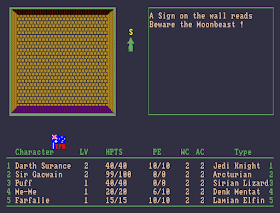 |
| A message very much in keeping with the Bard's Tale roots. |
Level 2 had less obvious structure than Level 1. It was dark, and flashlights run out pretty fast, so I had to load up before heading down. In one open area, I found the remains of a Jedi, along with a note that said an old man on the levels below knows something about coordinates. More important, the Jedi had a lightsaber, which I gave to my own Jedi. It works as both a weapon and a tool, but it only damages a single enemy.
 |
| In Star Wars, it wouldn't be something as pedestrian as a "tape recorder." It would have to have "holo" in the name. |
A final message on Level 2 said, "Face a wall you don't want and use the gadget!" I figured this referred to an "unknown gadget" sold in the shop on Level 1 for 30,000 credits. Ladders are one-way, so I had to find the way back up to Level 1 before my flashlight inventory ran out. When I got there, I spent my accumulated money on the gadget, and sure enough, it destroys any wall you're facing--once. The gadget is destroyed in the process, which is a pretty hefty expense to remove a wall. Still, when I did it in front of a single enclosed square on Level 1, it led me to some kind of portal.
So far, the levels haven't offered any navigation obstacles like teleporters or spinners. They've mostly featured large, one-way sections, with a couple of basic nods to rhyme and reason in the macro structure of the corridors and rooms.
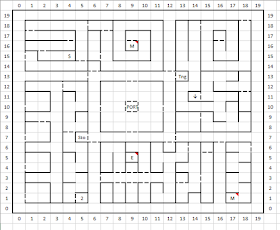 |
| Level 1 of the Citadel of Vras. |
The control scheme works well, supporting both mouse clicks and obvious keyboard commands. I'm avoiding the mouse because the jackasses that "cracked" the copy I found insisted in replacing the mouse cursor with the logo of their little club. They also might have messed with other aspects of the game. At one point, trying to load a saved game, I was instead taken to the "warez" screen with the message "naughty, naughty" for no reason that I could see. I'm going to have to rely mostly on save states for this one, but that's not really cheating because the game lets you save anywhere.
A couple of things make Vras slightly annoying beyond the fact that the game is a bit boring. First, random encounters (including enemies and lockers) don't trigger until you try to move out of a square. The graphics show you moving forward just before the enemy appears, but what really happens behind the scenes is that you get kicked back to the square you just left. This makes it easy to lose count of where you are when trying to map long corridors. Second, combat is slow. There's a speed setting, but even at the maximum setting, watching the actions crawl by is mildly torturous. I've tried speeding up the emulator, but nothing in WinUAE's settings seems to do the trick--I can't find anything akin to the "warp" mode of the C64 or Apple II emulators that I've come to love.
The developer, Sarva Engelhardt of Western Australia, has at least created a competent game here, but I suspect Levels 3-9 are just going to offer more of the same experience. Let's hope I'm wrong.

Congratulations on #300!
ReplyDelete(I guessed wrongly what game it would be, but that makes the milestone no less impressive.)
I probably should have tried harder to make it a more significant game. Maybe for # 500.
DeleteI thought it would be Wizardry VII who'd get the spot, but apparently I was wrong
DeleteThe "cleanup" games Dungeon und Doom Cavern pushed Wizardry VII to 302.
DeleteEh, numerology is silly and only paid attention to by people who tend to like astrology and fortune tellers. 300 is an index number, nothing more. No reason to get excited over it.
DeleteIt's more like a 'focal point' than numerology, and focal points are mutual fun for some of us :)
DeleteYeah, I don't think anyone thinks 300 is literally a magic number. It's just pleasingly neat-looking and round.
Delete300 is sort of like half of 600 and a full 100% more than 150 so it is an expressive and in the case of crpggames played for a blog significant number
DeleteIf 300 isn't an impressive number, find me another number that is a movie title which have buff Spartans kicking people into pits.
DeleteNeuronic whips were mentioned in Foundation... that may have been where they were borrowed from.
ReplyDeleteGiven BT heritage, how many combats per step? ;)
ReplyDeleteI'm guessing 'Arcturian' is an Arthurian reference (especially with the name), Sir Gawain and the Green Knight being a popular legend...
ReplyDeleteThis comment has been removed by the author.
DeleteThe character names are my own, but obviously I was riffing on the theme.
DeleteDarth Surance is the most chilling Sith name of them all...
ReplyDeleteThat looks like a Bard's Tale clone that might even be a little better than BT itself... but that's just because I like scifi settings since they're not as overused as fantasy, and because I never really liked BT that much due to its high encounter frequency ;)
ReplyDeleteIt's likely not worth the effort to backfill this for 300 games, and not always easy to identify, but a "lineage" field in the master game list would be interesting given all the games that have been derived from Wizardry, Bard's Tale and Ultima.
ReplyDeleteI loved the influenced-by graph in your "Early Years 1975-1983" posting.
I was curious about Megadisc and just where this game came from. I found a review, via Archive.org, on page 68 of the Volume 7 issue 1 of the "Australian Commodore and Amiga Review" magazine here (you can also just view the text of the doc in the download options on the right):
ReplyDeletehttps://archive.org/details/Australian_Commodore_and_Amiga_Review_The_Volume_7_Issue_1_1990-01_Saturday_Magazine_AU?q=citadel+vras
I've found this game only by the maker, a one Gyan Sarvagata," and no hits for that name unrelated to the game. A pseudonym? It does seem like a rather uncommon name.
The game was distributed by Megadisc, an Amiga disc magazine, whose editor was Tim Strachan. The above review notes that "the programmer had sent it to Tim with a simple request; 'Put it in your public domain collection, or throw it away.'" Hah! Sounds like the project turned into more than the creator had bargained for.
The review, however, notes that Strachan seemed to feel it was more worthy than just being a public domain game, and decided to sell it commercially. So, I'm not clear here: was it ultimately available via a standalone disk or in a pack? I see an ad for Megadisc on page 59. Ah, it mentions a "catalogue-on-disk" - I guess that was the route for a user to find it.
Great fun digging through that magazine (there are a lot more on archive.org). Re: page 33's advertisement - I didn't know that Commodore tried to dip their feet in the clone game! That final line in the blrb feels strangely tacked on, tho.
Hi. I was wondering the same myself. If there was a commercial release besides the magazine its cover or manual would pop-up on the internet. I am convinced that there was no box release on this one. Maybe you have an update?
DeleteI agree, it looks competently made, but just by reading "Jedi Knight" I would immediately realize that this one is not going to be innovative in any way.
ReplyDeleteFor some reason, these older games using something besides "HP" as an abbreviation for "Hit Points" always stands out for me.
ReplyDeleteThis comment has been removed by the author.
ReplyDelete"It feels like Sirian Lizard-Men have been in a lot of things."
ReplyDelete===================================
Given that this was created in the 1980s, my money is that Sirian Lizard-Men might be a reference to "V," given that the mini-series was extremely popular in the early 80s (and drew big ratings when it was rerun and released into syndication in or around 1987).
In "V," the aliens (known as Visitors) were lizard-men from the Sirius star system.
Good call. I keep meaning to re-watch that series, but I'm partly afraid it won't hold up. I was OBSESSED with it when I was a kid.
DeleteHeh, me too. I watched the initial TV movie/miniseries with my wife recently and we enjoyed it, but haven't gotten around to watching the second miniseries or the series itself yet.
DeleteIf I say to you that the password was "KYLE", you'll probably remember exactly what I mean...
Chet I hope you can persevere with this game. There just aren´t many that come out of Australia, nor are there many space rpg´s of any substance. It looks like a noble effort especially if it was from one lone programmer, and WA is quite a disconnected place to work from, deserving of even more kudos.
ReplyDeleteHi CRPGAddict! Are you still using Excel for drawing maps like the above or are you using another tool, e.g. Grid Cartographer?
ReplyDeleteStill using Excel. Still liking it just fine.
DeleteWould be interesting to see a video at some point on how you set that up and then do the actual mapping work.
DeleteThe word "denk" means "think" in Dutch, and of course mentats are a profession that's all about thinking. So that's a cute-sounding mystic word if you don't speak Dutch, and an all-too-easy synonym if you do...
ReplyDeleteThe same thing is true for German, too, by the way.
DeleteI have been lurking and reading your blog on and off for the last couple of months and I am enjoying it very much. A wonderful way to travel back in times to when C64 and Amiga 500 were populating my gaming desk.
ReplyDeleteI can't help but to notice that you have reached the year 1992 in your playthroughs. I literally cannot wait for you to play and assess the Darklands.
All the best!
I get such mixed messages on that game.
DeleteI got Darklands in a CD-ROM compilation in the mid-90s and never managed to get very far despite an interest. I think the simulation elements overwhelm the RPG ones and make it hard for me to find a productive path of progression.
DeleteIt´s interesting that so few commercial games on Amiga used this higher resolution. Yes, the palette is limited, but a good artist could make pretty stunning visuals with a bit of dithering. For some types of games, e.g. RPGs or adventures, this higher resolution seems criminally underused. What was the cause? Too large amount of graphic data? Or just a blind adherence to convention (everybody does 320x256, so we will do it as well)?
ReplyDeleteMany reasons. First is that non-square pixels are annoying. Second is that on a TV the bump in resolution isn't all that significant, especially when connected through the RF modulator. (At least here in Europe we had SCART so we often had RGB available. So it's more viable, but still...) Third is that it takes twice as much memory bandwidth and disk space (because your graphics are twice as big). Memory bandwidth is probably not important for a game like this, but it counts out action games. Disk space is obstacle for all kinds of games.
DeleteAnd of course the interlaced modes (480 lines) are right out, because they're unusable on a TV due to the flicker.
Wow, I really love the color palette in this game! Really nicely paired pastels, I think it makes it look more like a modern indie or experimental game (the static room art especially).
ReplyDeleteThe spaceport visual is stunningly evocative for the era. I probably would have left that screen open while doing my homework or something if I had played it back in the day. Well and been old enough for homework
DeleteNot just books and television shows, I see; you're fighting Antarans (from the Master of Orion series of 4X computer games).
ReplyDeleteWell, a shared etymology anyway. Antares is a pretty well known star. Master of Orion wasn't developed until 1993.
DeleteAnd it's an 1991 RPG from Switzerland.
Delete